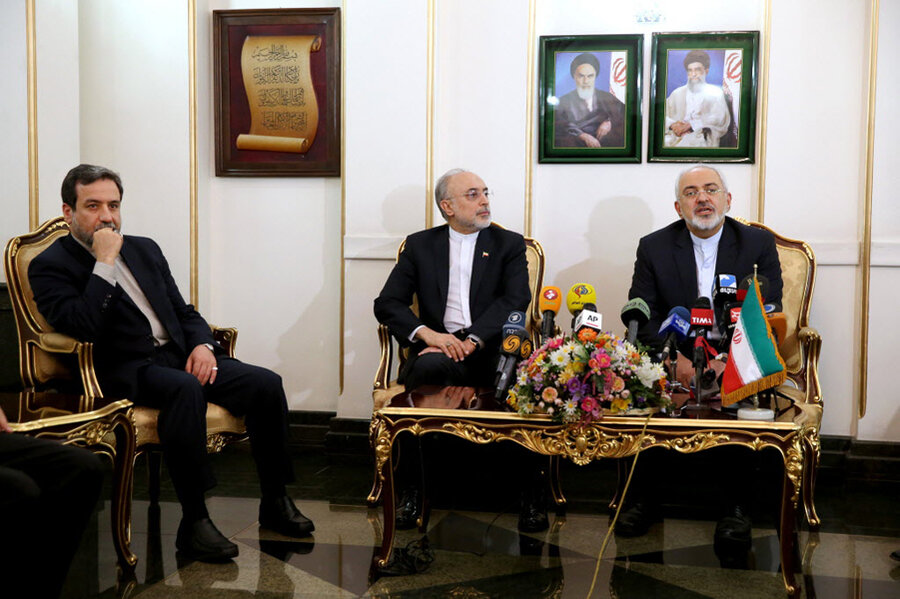Iran nuclear deal: A quick guide to what's missing
Loading...
| Washington
There are lots of specifics for US officials to like in the new Iranian nuclear framework. Iran’s negotiators agreed to give up about two-thirds of their working centrifuges, for example. That’s a big reduction in machinery which could (potentially) produce uranium enriched to weapons-grade levels. Furthermore, Iran agreed that all remaining working centrifuges would be first-generation IR-1s, which in technological terms are obsolete – the Ford Pintos of gaseous diffusion.
Iran’s promised to not enrich any uranium above a low 3.67 percent level for at least 15 years. It says it will shrink its current stockpile of enriched fissile material from about 10,000 kilograms to 300 kg. And so on.
But remember, this is a framework. It’s an outline, a first draft, a plan of action for decisions which have yet to be made. There are a number of very important aspects of Iran’s program which aren’t addressed, but would almost certainly have to be part of a signed-and-sealed deal. Here are a few:
What happens to uranium? Yes, Iran says it will reduce its stockpile of low-enriched uranium. But the framework is silent on how that will happen. US negotiators have long pushed for Iran to export much of its fissile material to a third party, probably Russia. Earlier this week Iran’s deputy foreign minister said that won’t happen, though. Will the uranium be downblended, or mixed with non-enriched stuff to make it harmless? Will the US and other great powers accept that? Stay tuned.
When will sanctions be lifted? In return for denaturing its nuclear activities, Iran would receive relief from international sanctions that have crippled its domestic economy. It’s not clear from the US-supplied agreement details exactly when that would happen, though.
The wording is vague. It says only that sanctions will be taken off after the International Atomic Energy Association (IAEA) has verified that Iran has taken all required nuclear steps. Secretary of State John Kerry, in his press conference after the deal, insisted this relief would occur in phases. That implies it would occur gradually over a perhaps-lengthy period of time.
That’s not the way Iranian officials are describing their prospective sanctions relief. In his public statements since the deal was announced, Iranian Foreign Minister Mohammad Javad Zarif has implied that the restrictions would be lifted earlier than Secretary Kerry’s announced timetable. Mr. Zarif has reacted angrily to the notion that this relief would be gradual, as well as to the US publication of purported agreement points.
“There is no need to spin using ‘fact sheets’ so early on,” Zarif tweeted on Thursday.
Will Iran discuss its old nuclear activities? International verification of Iran’s compliance with any nuclear deal remains an area where it seems as if the parties haven’t reached complete specific agreement.
There were some important Iranian concessions in this area, according to the US version of events. The State Department’s summary said that IAEA inspectors will have access to Iranian uranium mines, as well as to the “supply chain that supports Iran’s nuclear program.” That would greatly expand IAEA access – something the UN-sponsored agency has long pushed for.
“That’s a huge contribution at least potentially to ensuring that Iran doesn’t have any undeclared nuclear activities,” said proliferation nuclear nonproliferation expert George Perkovich of the Carnegie Endowment for International Peace.
But will Iran let international inspectors go anywhere, anytime? The IAEA wants to re-check the Parchin military complex, for example. Intelligence obtained by the agency indicates Iran has carried out non-nuclear explosive work related to atomic weapons at that facility. So far Iran has refused the IAEA’s request.
Perhaps more importantly, will Iran talk about what the IAEA calls “possible military dimensions”?
Some years ago the IAEA obtained a pile of intelligence that indicated Iran had done a series of things related to nuclear weapons development, from work on high-voltage detonators, to a study of how to fit a nuclear bomb in a missile nose cone. Beginning in 2011, the agency asked Iran to explain this stuff. For the most part the Iranians have not, saying the evidence is faked.
The US version of the nuclear framework says only that Iran will “implement an agreed set of measures” to address the IAEA’s concerns about these possible military dimensions. What does that mean?
It may mean they’ve kicked this provision down the road for further negotiation. Lots of work remains before the framework becomes a real agreement.








